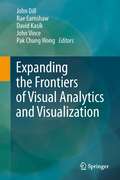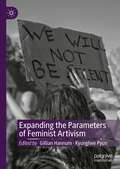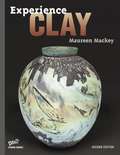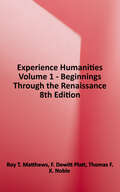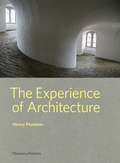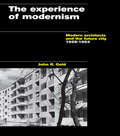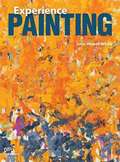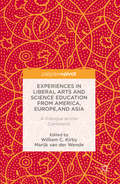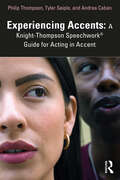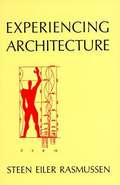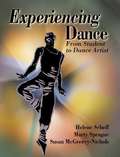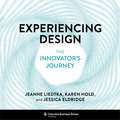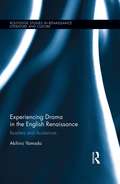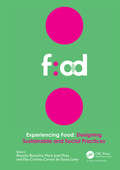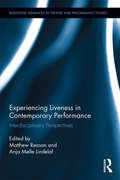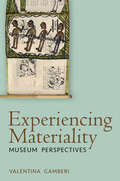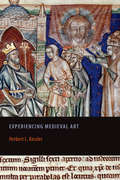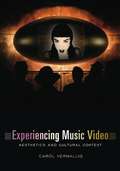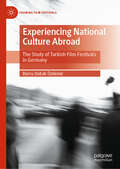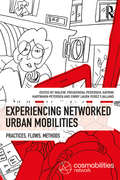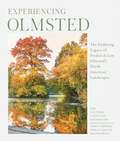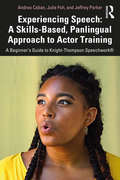- Table View
- List View
Expanding the Frontiers of Visual Analytics and Visualization
by Pak Chung Wong John Vince Rae Earnshaw David Kasik John DillThe field of computer graphics combines display hardware, software, and interactive techniques in order to display and interact with data generated by applications. Visualization is concerned with exploring data and information graphically in such a way as to gain information from the data and determine significance. Visual analytics is the science of analytical reasoning facilitated by interactive visual interfaces. Expanding the Frontiers of Visual Analytics and Visualization provides a review of the state of the art in computer graphics, visualization, and visual analytics by researchers and developers who are closely involved in pioneering the latest advances in the field. It is a unique presentation of multi-disciplinary aspects in visualization and visual analytics, architecture and displays, augmented reality, the use of color, user interfaces and cognitive aspects, and technology transfer. It provides readers with insights into the latest developments in areas such as new displays and new display processors, new collaboration technologies, the role of visual, multimedia, and multimodal user interfaces, visual analysis at extreme scale, and adaptive visualization.
Expanding the Parameters of Feminist Artivism
by Gillian Hannum Kyunghee PyunThis book explores the work and careers of women, trans, and third-gender artists engaged in political activism. While some artists negotiated their own political status in their indigenous communities, others responded to global issues of military dictatorship, racial discrimination, or masculine privilege in regions other than their own. Women, trans, and third-gender artists continue to highlight and challenge the disturbing legacies of colonialism, imperialism, capitalism, communism, and other political ideologies that are correlated with patriarchy, primogeniture, sexism, or misogyny. The book argues that solidarity among such artists remains valuable and empowering for those who still seek legitimate recognition in art schools, cultural institutions, and the history curriculum.
Experience Clay
by Maureen MackeyBrings an ancient art form to the contemporary classroom, inspiring students with exciting images, clear instruction, and fundamental background. This contemporary guide to clay techniques, tools, and traditions is as inspirational as it is practical. Supported by clear, step-by-step illustrations, this comprehensive resource details a range of handbuilding and wheel-throwing techniques and is a wonderful source for exploring ancient traditions and historic innovations in the world ofceramic art. From the properties of clay to decoration and firing, all information presented is shown against a rich backdrop of dynamic professional and student work. The student text explores ancient traditions and historic innovations. It also includes carefully crafted lessons organized for success in creating art and mastering key concepts and skills while introducing students to: * Contemporary masters * Cutting-edge works of art * New media * Techniques and safety precautions *Current careers in art
Experience Humanities Volume 1 - Beginnings Through the Renaissance, 8th Edition
by Roy T. Matthews F. Dewitt Platt Thomas F. X. NobleThe humanities are alive. We see the great pyramids in contemporary design, we hear Bach in hip-hop and pop music, and we feel ancient religious themes and philosophies in our impassioned contemporary dialogues. Experience Humanities invites students to take note of the continual evolution of ideas and cross-cultural influences to better understand the cultural heritage of the West, and to think critically about what their legacy will be for future generations. Together with Connect® Humanities, a groundbreaking digital learning solution, students not only experience their cultural heritage, but develop crucial critical reading, thinking, and writing skills that will prepare them to succeed in their humanities course and beyond.
The Experience of Architecture
by Henry PlummerA thought-provoking consideration of how architecture, from a doorknob to a city plan, can influence human behavior How does the experience of turning a door handle, opening a door from one space into another, affect us? It is no wonder that the door, one of the most elemental architectural forms, has such metaphorical richness. But even on a purely physical human level, the cold touch of a brass handle or the swish of a sliding screen gives rise to an emotional reaction, sometimes modest, occasionally profound. This book aims to understand how these everyday acts are influenced by architectural form, a concept that is vital for all architects to grasp. It considers how specifically built elements and volumes, taken from a wide array of buildings and settings around the world, can affect our powers of decision. From hand-carved stairs in Greek villages to free-floating catwalks, from the elegant processional steps of Renaissance Italy to Frank Lloyd Wright's masterly manipulation of form, all provide very different experiences of stepping from one level to the next, and all affect our experience of that space. Seamlessly integrating text and image, each chapter focuses on a different aspect of our daily interactions with architecture, looking at stairs, floors and paths, moving interior spaces, perception and perspective, transparency and the relationship between a building and its setting. This book is not just for architects and designers engaged in the production of space, but for all those who seek a richer understanding of their place in the built world.
The Experience of Modernism: Modern Architects and the Future City, 1928-53
by John R. GoldMaking extensive use of information gained from in-depth interviews with architects active in the period between 1928-1953, the author provides a sympathetic understanding of the Modern Movement's architectural role in reshaping the fabric and structure of British metropolitan cities in the post-war period and traces the links between the experience of British modernists and the wider international modern movement.
Experience Printmaking
by Donna AndersonThis studio textbook program is a visually dynamic and extensive resource, specifically designed to fit a range of teaching styles, instructional needs, and classroom configurations. This curriculum covers all printmaking processes including: relief, intaglio, planography, and serigraphy. Students will have the opportunity to explore their own unique style and interests, through stimulating hands-on studio opportunities, from basic to advanced levels. Some of the features included in thistextbook to help make it the most valuable tool in the printmaking classroom are: * Key Terms - Important terms are highlighted and defined the first time they appear. Use these words to build your student's printmaking vocabulary. * In-depth Profiles - This feature highlights the historical and cultural influences that shape significant prints. * Step by Step How-To's - Diagrams and instructions that illustrate fundamental skills and techniques. * Student Artwork - Images included in each chapter encourage peer sharing and critique.
Experiences in Liberal Arts and Science Education from America, Europe, and Asia
by William C. Kirby Marijk C. van der WendeThis book highlights the experiences of international leaders in liberal arts and science education from around the world as they discuss regional trends and models, with a specific focus on developments in and cooperation with China. Focusing on why this model responds to the twenty-first century requirements for excellence and relevance in undergraduate education, contributors examine if it can be implemented in different contexts and across academic cultures, structures, and traditions.
Experiencing Accents: A Knight-Thompson Speechwork® Guide for Acting in Accent
by Philip Thompson Tyler Seiple Andrea CabanExperiencing Accents: A Knight-Thompson Speechwork® Guide for Acting in Accent presents a comprehensive and systematic approach to accent acquisition for actors. It lays out an accessible and effective set of tools, exercises, and theoretical frameworks grounded in current linguistic science, as well as more than two decades of teaching, actor training, and coaching developed by Knight-Thompson Speechwork®. This book dismantles the notions that accents exist on a spectrum of good and bad or that "neutral," "general," or "standard" can serve as ideals for speech. By de-centering elitist and authoritarian worldviews, it gives actors a path to mobilize their innate language abilities to acquire any accent, relying on descriptive and experiential knowledge. The innovative approach of the Four Ps – People, Prosody, Posture, and Pronunciation – builds cultural competence that honors accents as they exist in the world, increases the physical and perceptive skills of the actor, and provides a rich variety of applications to encourage fluid and embodied accent performance. Each of the Four Ps are investigated and practiced separately and then synthesized in the art of the performer, allowing actors to address the complexity of acting in accent through a deliberate and sequential layering of skills, rendering the final expression of their technique meticulously accurate and deeply authentic. Organized into fifteen modules to correspond with a typical semester, Experiencing Accents is perfect for Theatre students in voice, speech, and accents courses, along with working actors interested in improving their accent work.
Experiencing Architecture
by Steen RasmussenWidely regarded as a classic in the field, Experiencing Architecture explores the history and promise of good design. Generously illustrated with historical examples of designing excellence -- ranging from teacups, riding boots, and golf balls to the villas of Palladio and the fish-feeding pavilion of Beijing's Winter Palace--Rasmussen's accessible guide invites us to appreciate architecture not only as a profession, but as an art that shapes everyday experience.
Experiencing Architecture
by Steen Eiler RasmussenA classic examination of superb design through the centuries. Widely regarded as a classic in the field, Experiencing Architecture explores the history and promise of good design. Generously illustrated with historical examples of designing excellence—ranging from teacups, riding boots, and golf balls to the villas of Palladio and the fish-feeding pavilion of Beijing's Winter Palace—Rasmussen's accessible guide invites us to appreciate architecture not only as a profession, but as an art that shapes everyday experience.In the past, Rasmussen argues, architecture was not just an individual pursuit, but a community undertaking. Dwellings were built with a natural feeling for place, materials and use, resulting in “a remarkably suitable comeliness.” While we cannot return to a former age, Rasmussen notes, we can still design spaces that are beautiful and useful by seeking to understand architecture as an art form that must be experienced. An understanding of good design comes not only from one's professional experience of architecture as an abstract, individual pursuit, but also from one's shared, everyday experience of architecture in real time—its particular use of light, color, shape, scale, texture, rhythm and sound. Experiencing Architecture reminds us of what good architectural design has accomplished over time, what it can accomplish still, and why it is worth pursuing. Wide-ranging and approachable, it is for anyone who has ever wondered “what instrument the architect plays on.”
Experiencing Dance: From Student to Dance Artist
by Helene Scheff Marty Sprague Susan Mcgreevy-NicholsIn this text for students who have had some experience in dance, Scheff, a dance educator, presents 45 self-paced lessons, plus guidelines for building a portfolio, that will help students understand dance as an art form, create and perform dances, evaluate and critique dance, and understand cultural influences on dance. Each chapter includes objectives, three or four lessons, portfolio items, and a quiz. The book offers a complete curriculum progression that can also be used to supplement an existing curriculum. B&w photos and drawings are included. There is no subject index. Annotation ©2004 Book News, Inc. , Portland, OR (booknews. com)
Experiencing Design: The Innovator's Journey
by Jeanne Liedtka Karen Hold Jessica EldridgeIn daylong hackathons, design thinking seems deceptively easy. On the surface, it involves a set of seemingly simple activities such as gathering data, identifying insights, generating ideas, prototyping, and experimentation. But practiced at a superficial level, even great design tools don’t go deep enough to create the shifts in mindset and skillset that are required to achieve transformational impact. Going deep with design requires more than changing the activities of innovators; it involves creating the conditions that shape who they become. Individuals become design thinkers by experiencing design.Drawing on decades of researching design thinking and teaching it to people not trained in design, Jeanne Liedtka, Karen Hold, and Jessica Eldridge offer a guide for how to create these deep experiences at each stage of the design thinking journey, whether for an individual, a team, or an organization. For each experience phase, they specify the mindset shifts and competencies that need to be achieved, describe how different personality types experience different kinds of journeys, and show how to fully leverage the diversity of teams. Experiencing Design explores both the science and practicalities of design and includes two assessment instruments for individual and organizational development.Ultimately, innovators need to be someone new to create something new. This book shows you how to use design thinking to make this happen.
Experiencing Drama in the English Renaissance: Readers and Audiences (Routledge Studies in Renaissance Literature and Culture)
by Akihiro YamadaThis book investigates the complex interactions, through experiencing drama, of readers and audiences in the English Renaissance. Around 1500 an absolute majority of population was illiterate. Henry VIII’s religious reformation changed this cultural structure of society. ‘The Act for the Advancement of True Religion’ of 1543, which prohibited the people belonging to the lower classes of society as well as women from reading the Bible, rather suggests that there already existed a number of these folks actively engaged in reading. The Act did not ban the works of Chaucer and Gower and stories of men’s lives – good reading for them. The successive sovereigns’ educational policies also contributed to rising literacy. This trend was speeded up by London’s growing population which invited the rise of commercial playhouses since 1567. Every citizen saw on average about seven performances every year: that is, about three per cent of London’s population saw a performance a day. From 1586 onwards merchants’ appearance in best-seller literature began to increase while stage representation of reading/writing scenes also increased and stimulated audiences towards reading. This was spurred by standardisation of the printing format of playbooks in the early 1580s and play-minded readers went to playbooks, eventually to create a class of playbook readers. Late in the 1590s, at last, playbooks matched with prose writings in ratio to all publications. Parts I and II of this book discuss these topics in numerical terms as much as possible and Part III discusses some monumental characteristics of contemporary readers of Chapman, Ford, Marston and Shakespeare.
Experiencing Food: Proceedings of the 2nd International Conference on Food Design and Food Studies (EFOOD 2019), 28-30 November 2019, Lisbon, Portugal
by Ricardo Bonacho Maria José Pires Elsa Cristina Carona de Sousa LamyExperiencing Food: Designing Sustainable and Social Practices contains papers on food, sustainability and social practices research, presented at the 2nd International Conference on Food Design and Food Studies, held November 28-30, 2019, at the Faculty of Architecture, University of Lisbon, Lisbon, Portugal. The conference and resulting papers reflect on interdisciplinarity as not limited to the design of objects or services, but seeking awareness towards new lifestyles and innovative approaches to food sustainability.
Experiencing Liveness in Contemporary Performance: Interdisciplinary Perspectives (Routledge Advances in Theatre & Performance Studies)
by Matthew Reason Anja Mølle LindelofThis volume brings together dynamic perspectives on the concept of liveness in the performing arts, engaging with the live through the particular analytical focus of audiences and experience. The status and significance of the live in performance has become contested: perceived as variously as a marker of ontological difference, a promotional slogan, or a mystical evocation of cultural value. Moving beyond debates about the relationship between the live and the mediated, this collection considers what we can know and say about liveness in terms of processes of experiencing and processes of making. Drawing together contributions from theatre, music, dance, and performance art, it takes an interdisciplinary approach in asking not what liveness is, but how it matters and to whom. The book invites readers to consider how liveness is produced through processes of audiencing - as spectators bring qualities of (a)liveness into being through the nature of their attention - and how it becomes materialized in acts of performance, acts of making, acts of archiving, and acts of remembering. Theoretical chapters and practice-based reflections explore liveness, eventness and nowness as key concepts in a range of topics such as affect, documentation, embodiment, fandom, and temporality, showing how the relationship between audience and event is rarely singular and more often malleable and multiple. With its focus on experiencing liveness, this collection will be of interest to disciplines including performance, audience and cultural studies, visual arts, cinema, and sound technologies.
Experiencing Materiality: Museum Perspectives
by Valentina GamberiRepresenting a cutting-edge study of the junction between theoretical anthropology, material culture studies, religious studies and museum anthropology, this study examines the interaction between the human and the nonhuman in a museum setting usually defined as ‘non-Western’, ‘non-scientific’ and ‘religious.’ Combining an on-site analysis of exhibitive spaces with archival research and interviews with museum curators, the chapters highlight contradictions of museum practices, and suggests that museum practitioners use museum spaces and artefacts as a way of formulating new theoretical stances in material culture studies, thus viewing museums as producers of theories together with affective engagements.
Experiencing Medieval Art (Rethinking the Middle Ages)
by Herbert L. KesslerExperiencing Medieval Art is an extensive revision and expansion of the author’s Seeing Medieval Art, originally published in 2004. Renowned art historian Herbert L. Kessler considers often-strange objects and the materials of which they are made, circumstances of production, the conflictual relationship between art objects and notions of an ineffable deity, the context surrounding medieval art, the playfulness of art and the formal movements it engaged, as well as questions of apprehension, aesthetics, and modern presentation. Kessler introduces the exciting discoveries and revelations that have revolutionized the understanding of medieval art and identifies the vexing challenges that still remain. Examining such well-known monuments as the stained glass in Chartres cathedral, mosaics in San Marco Venice, and Utrecht Psalter, as well as newly discovered works – including the frescoes in Rome’s "aula gotica" and a twelfth-century aquamanile in Hildesheim – Kessler makes the complex history of medieval art accessible for students of art history, teachers in the field, and scholars of medieval history, theology, and literature.
Experiencing Music Video: Aesthetics and Cultural Context
by Carol VernallisMusic videos have ranged from simple tableaux of a band playing its instruments to multimillion dollar, high-concept extravaganzas. Born of a sudden expansion in new broadcast channels, music videos continue to exert an enormous influence on popular music. They help to create an artist's identity, to affect a song's mood, to determine chart success: the music video has changed our idea of the popular song.Here at last is a study that treats music video as a distinct multimedia artistic genre, different from film, television, and indeed from the songs they illuminate—and sell. Carol Vernallis describes how verbal, musical, and visual codes combine in music video to create defining representations of race, class, gender, sexuality, and performance. The book explores the complex interactions of narrative, settings, props, costumes, lyrics, and much more. Three chapters contain close analyses of important videos: Madonna's "Cherish," Prince's "Gett Off," and Peter Gabriel's "Mercy St."
Experiencing Music Video: Aesthetics and Cultural Context
by Carol VernallisHere at last is a study that treats music video as a distinct multimedia artistic genre, different from film, television, and indeed from songs themselves. Carol Vernallis describes how musical, visual and verbal codes work together in music video and reveals modes of representing race, class, gender, and sexuality that characterize the music video form.
Experiencing National Culture Abroad: The Study of Turkish Film Festivals in Germany (Framing Film Festivals)
by Burcu Dabak ÖzdemirImmigrant film festivals are multifaceted events where complex networks of identities and symbolic values are constructed, circulated, and debated through various channels, including program screenings, ancillary events, press releases, financial backing, and audience engagement. As such, immigrant film festivals can be seen as discourse-producing practices. Based on this idea, this book offers a comprehensive study of three prominent Turkish film festivals in Germany: the International Frankfurt Turkish Film Festival, the Nuremberg Turkey/Germany Film Festival, and the Munich Turkish Film Days. The overarching objective is to comprehend the multifaceted influence of these festivals on the construction of discourses on Turkish immigrant identity while also seeking to illuminate how these festivals reshape both the host country and the country of origin and produce ideas for Turkish immigrants This is achieved through an examination of the diverse representation strategies engendered by these festivals. By employing a multifaceted research approach—including content analysis, audience studies, semi-structured interviews with festival managers, and participant observation—this study seeks to provide a nuanced understanding of the complex interplay between immigrant film festivals, cultural identity formation, and the socio-political dynamics within both the host and origin countries. Through rigorous scholarly inquiry, it aims to contribute to academic discourse on the role of film festivals in shaping cultural narratives, fostering intercultural dialogue, and facilitating processes of integration and belonging within immigrant communities.
Experiencing Networked Urban Mobilities: Practices, Flows, Methods (Networked Urban Mobilities Series)
by Malene Freudendal-Pedersen Katrine Hartmann-Petersen Emmy Laura Perez FjallandExperiencing Networked Urban Mobilities looks at the different experiences of networked urban mobilities. While the focus in the first book is on conceptual and theory-driven perspective, this second volume emphasizes the empirical investigation of networked urban mobilities. This book is a resource for researchers interested in the field to gain easy access and overviews of different themes and approaches represented in the mobilities paradigm.
Experiencing Olmsted: The Enduring Legacy of Frederick Law Olmsted's North American Landscapes
by The Cultural Landscape Foundation Charles Birnbaum Dena Tasse-Winter Arleyn Levee200 Iconic Landscapes That Define North America Frederick Law Olmsted is the father of American landscape architecture. His firm, and the successor firms that sprung from it, worked through the nineteenth and twentieth centuries to shape some of our most beloved green spaces, including national, state, and city parks, suburban neighborhoods, and academic campuses. He is most famous for creating New York&’s Central and Prospect Parks, Stanford University&’s campus, and the Capitol Grounds. What is less known and surprising about his legacy is that he worked widely across North America. By highlighting 200 iconic landscapes, many of which are still open to the public today, Experiencing Olmsted brings a fresh approach to the firms&’ work and philosophy. It highlights not only grand city parks, but also other public venues born out of a desire for social equity. Olmsted was an early voice for parks as democratic spaces that could be reached on foot by a large percentage of any city&’s populace. He viewed parks as restorative places—what he termed &“the lungs of a city.&” Brimming with contemporary and archival photography as well as original drawings and plans, this truly remarkable record brings these places to vivid life.
Experiencing Speech: A Beginner's Guide to Knight-Thompson Speechwork®
by Andrea Caban Julie Foh Jeffrey ParkerExperiencing Speech: A Skills-Based, Panlingual Approach to Actor Training is a beginner’s guide to Knight-Thompson Speechwork®, a method that focuses on universal and inclusive speech training for actors from all language, racial, cultural, and gender backgrounds and identities. This book provides a progression of playful, practical exercises designed to build a truly universal set of speech skills that any actor can use, such as the ability to identify, discern, and execute every sound found in every language on the planet. By observing different types of flow through the vocal tract, vocal tract anatomy, articulator actions, and how these components can be combined, readers will understand and recreate the process by which language is learned. They will then be introduced to the International Phonetic Alphabet (IPA) and will practice using the IPA for narrow transcription of speech sounds. The book also offers both an intellectual and physical understanding of oral posture and how it contributes to vocal characterization and accent work. This approach to speech training is descriptive, giving students a wide and diverse set of speech sounds and skills to utilize for any character in any project, and it establishes a foundation for future accent study and acquisition. Experiencing Speech: A Skills-Based, Panlingual Approach to Actor Training is an excellent resource for teachers and students of speech and actor training, as well as aspiring actors looking to diversify their speech skills.
